Rubberwood may not be the first thing that comes to mind when considering eco-friendly materials. However, rubberwood can be a great choice for your eco-friendly home.
Rubberwood is the perfect choice for sustainable and eco-friendly wood for your home decor and furniture. For many years rubberwood could not be used, but in the 1980s, new technology was invented that helped rubberwood become one of the most sought-after hardwoods. There are many advantages to using rubberwood for furniture and home decor products and why it is considered a responsible environmental choice.
Table of Contents
- Rubberwood The Perfect Choice For Your Eco-friendly Home
- The Technology That Ensured Rubberwood Is Now A Great Hardwood
- Advantages Of Using Rubberwood For Furniture And Home Decor
- 10 Reasons Why Rubberwood Is The Eco-Friendly Choice For Your Home Decor And Home Furnishing Choice
- Rubberwood Is A Byproduct Of The Rubber Industry
- Rubberwood Is A Renewable Resource
- Rubberwood Is A Durable And Long-Lasting Material
- Rubberwood Is Easy To Work With
- Rubberwood Is Affordable
- Rubberwood Is Biodegradable
- Rubberwood Is Chemical-Free
- Rubberwood Supports Local Communities
- Rubberwood Reduces Deforestation
- Rubberwood Promotes Sustainable Practices
- Rubberwood Is A Renewable Resource
- 10 Interesting Facts About Rubberwood
- Partnering With Mondoro: Creating Beautiful And Sustainable Rubberwood Home Decor Together
- Frequently Asked Questions About Rubberwood
- Related Content
Read on to discover why rubberwood is an eco-friendly choice for an eco-friendly-conscious home.
Rubberwood The Perfect Choice For Your Eco-friendly Home
Rubberwood is an incredibly sustainable and eco-friendly choice for furniture and home decor. The history of rubberwood shows how it became a sustainable material and why rubberwood has many advantages for furniture and home decor products.
Rubberwood is considered a responsible choice for the environment.
A Brief History Of Rubberwood

Rubberwood comes from the Hevea Brasiliensis tree, primarily grown in Southeast Asia. The tree produces latex, which is harvested for rubber production.
In the past, when a rubber tree reached the end of its latex-producing life cycle, it was cut down and burned. The wood was not used and was seen as a waste product that needed to be burned down.
In the 1980s, technology advanced to where the wood from the rubber tree could be used for furniture and other products. This discovery not only prevented the waste of a valuable resource but also helped to reduce deforestation.
Because of this new technology, the demand for rubberwood furniture and home decor products has increased over the years; it is now one of the most popular hardwoods used in furniture and home decor production.
The Technology That Ensured Rubberwood Is Now A Great Hardwood
While rubberwood may seem like the perfect solution to the problem of waste from the rubber tree, it is not as simple as using rubberwood; it was not easy to find a way to use the wood from the rubber tree.
When the rubber tree is tapped for latex, it produces a sap that can get into the wood, making it unsuitable for furniture or home decor production. If the wood is not treated correctly, it can warp and split, making it useless for furniture and home decor or any other kind of manufacturing.
To overcome this issue, a technology was developed to ensure that rubberwood could be used for production. This process involves kiln-drying the rubberwood to remove the moisture and helps prevent warping and splitting.

The wood is then treated with chemicals to remove any remaining sap and prevent future infestations of insects and fungi. This process ensures the wood is stable and durable, making it perfect for furniture and home decor.
Rubberwood Does Not Contain Any Latex
It is a common misconception that rubberwood contains latex, but it does not. Even though, Rubberwood comes from the Hevea Brasiliensis tree, primarily grown for latex production.
Once the tree stops producing latex, it is cut down, and the wood is treated for furniture production. However, preparing the wood for furniture production involves removing all the latex content from the wood so it does not contain any latex.
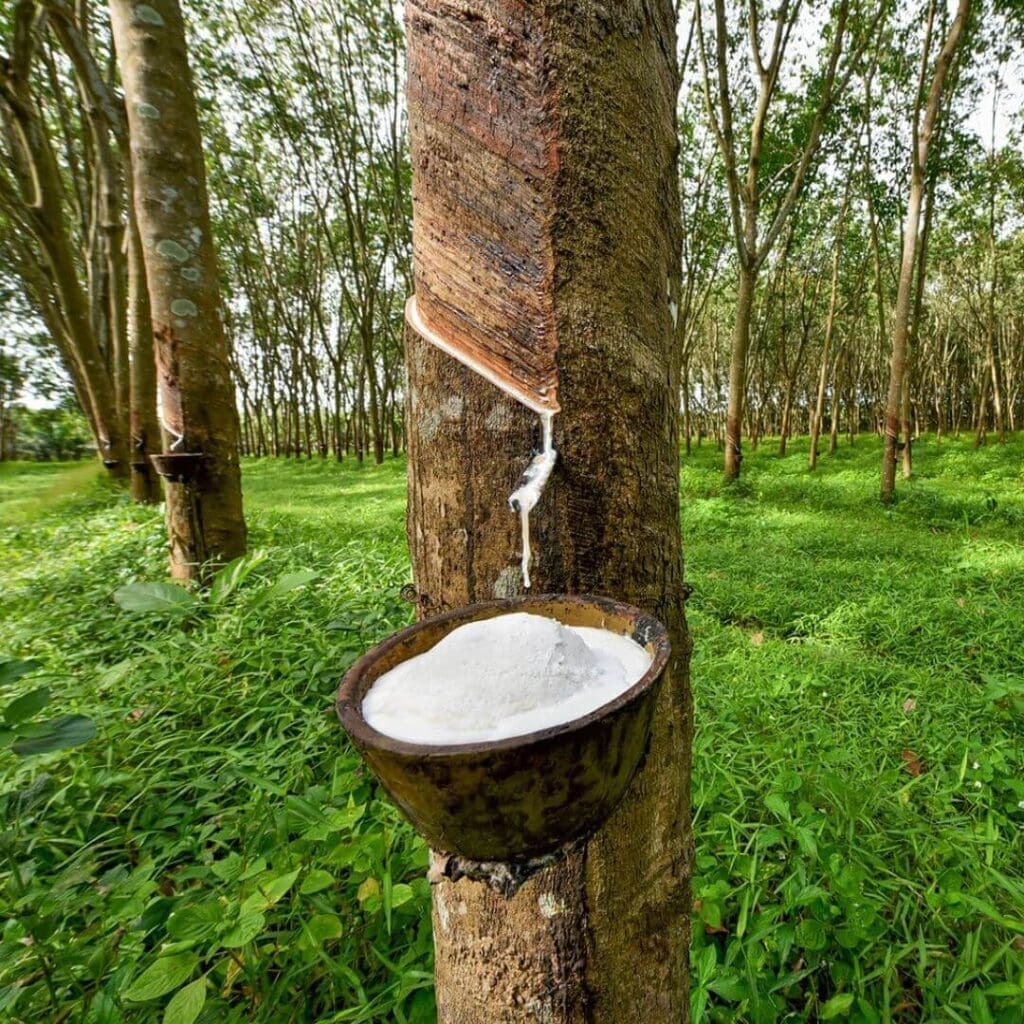
This is excellent news for people who are allergic to latex. Latex allergy is a common condition that affects many people worldwide. I also have a latex allergy and have never had any issues handling rubberwood.
Rubberwood is a sustainable and eco-friendly choice for furniture and home decor. It does not contain latex, making it safe for people with latex allergies. By using rubberwood, we can reduce waste, promote sustainable practices, and create beautiful and functional home pieces.
Advantages Of Using Rubberwood For Furniture And Home Decor
Rubberwood is an excellent choice for furniture and home decor for several reasons. Here are some of the top reasons why we love rubberwood:
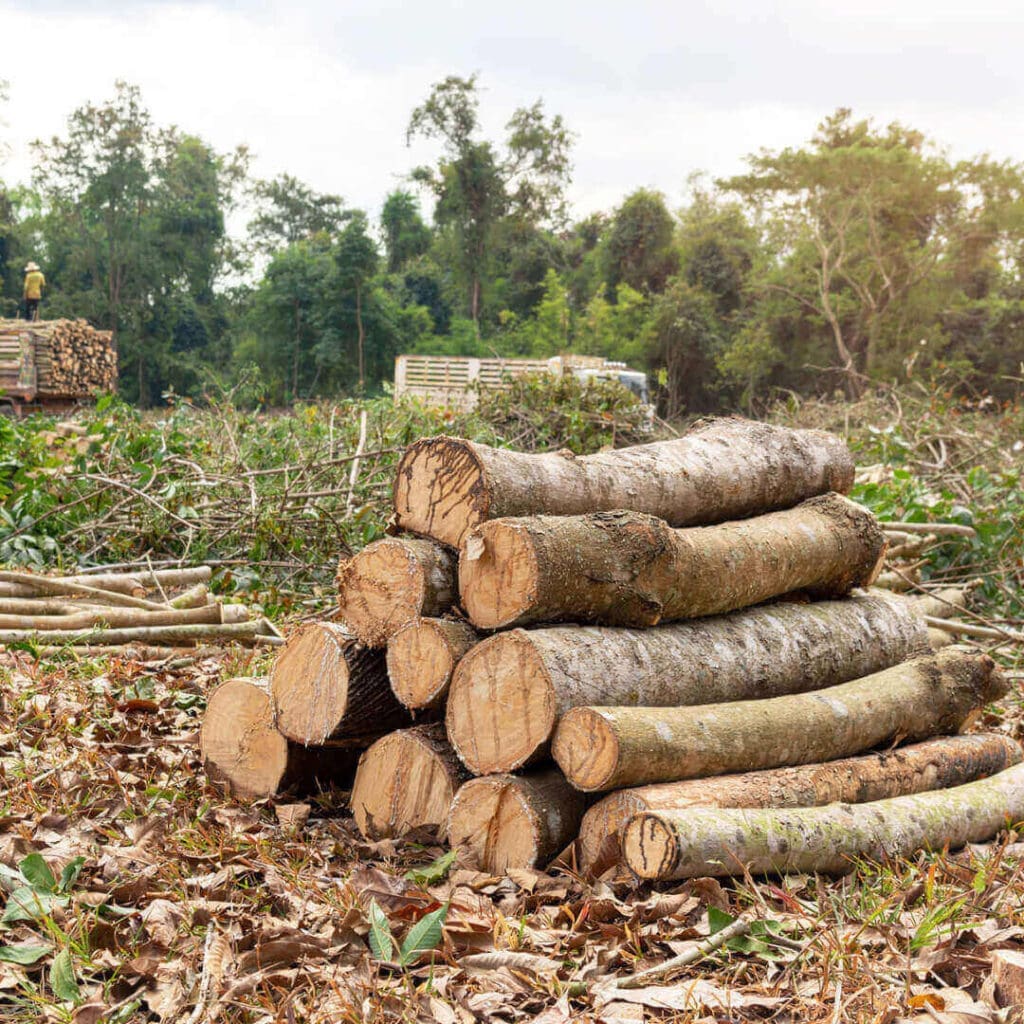
Rubberwood Is A Hardwood
Rubberwood is a durable hardwood. This durability also means that furniture made from rubberwood will last longer, reducing the need for replacement furniture and, therefore, reducing waste.
Rubberwood Is Easy To Work With
Another advantage of using rubberwood is that it is easy to work with. It can be cut, sanded, and shaped quickly, making it ideal for furniture production. It also takes stains and finishes nicely, so it can be customized to match any decor style.
Rubberwood Is An Affordable Hardwood
Rubberwood is also affordable hardwood compared to other hardwoods like oak or walnut. This affordability makes it an accessible option for those who want high-quality furniture but cannot afford the high prices of other hardwoods.
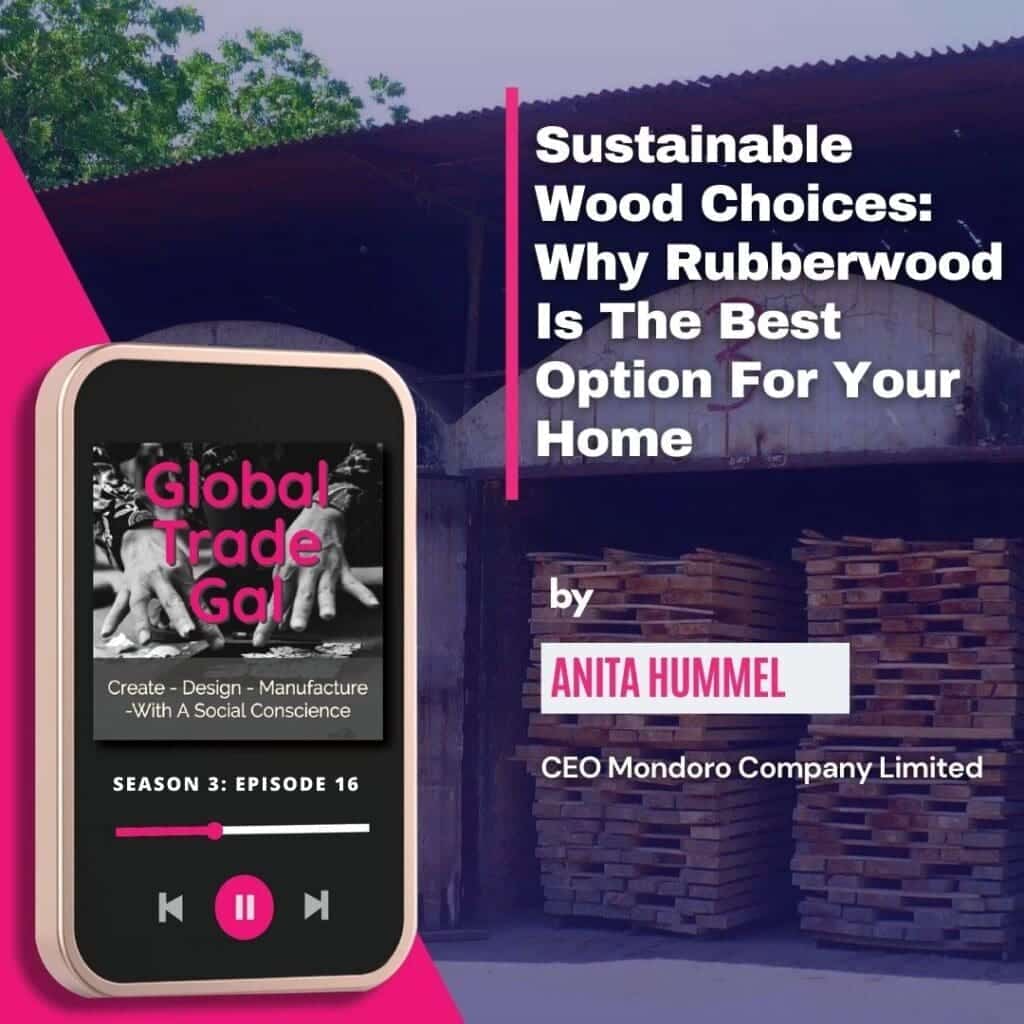
Listen To Our Podcast Sustainable Wood Choices: Why Rubberwood Is The Best Option For Your Home below or by clicking here.
10 Reasons Why Rubberwood Is The Eco-Friendly Choice For Your Home Decor And Home Furnishing Choice
One of the most significant advantages of rubberwood is that it is an incredibly sustainable and eco-friendly option for furniture and home decor. Rubberwood was once a waste product that was burned.
By using rubberwood, we are preventing the waste of a valuable resource and reducing the need for new trees to be cut down.
Here are ten of our top reasons why we love rubberwood as a sustainable wood choice:
Rubberwood Is A Byproduct Of The Rubber Industry
Rubberwood comes from the Hevea Brasiliensis tree, primarily grown for latex production. Once the tree stops producing latex, it is cut down and used for furniture production, preventing waste.

Rubberwood Is A Renewable Resource
After the last tree is cut down, the Hevea Brasiliensis tree can be replanted for latex production. The rubber trees must be replanted anyway, so rubberwood is a renewable resource for production and manufacturing.
Rubberwood Is A Durable And Long-Lasting Material
Rubberwood is a hardwood, which means it is sturdy and can withstand wear and tear over time. This means that furniture made from rubberwood will last longer and reduce the need for replacement furniture.
Rubberwood Is Easy To Work With
Rubberwood can be cut, sanded, and shaped quickly, making it ideal for furniture production. It also takes stains and finishes nicely, so it can be customized to match any decor style.
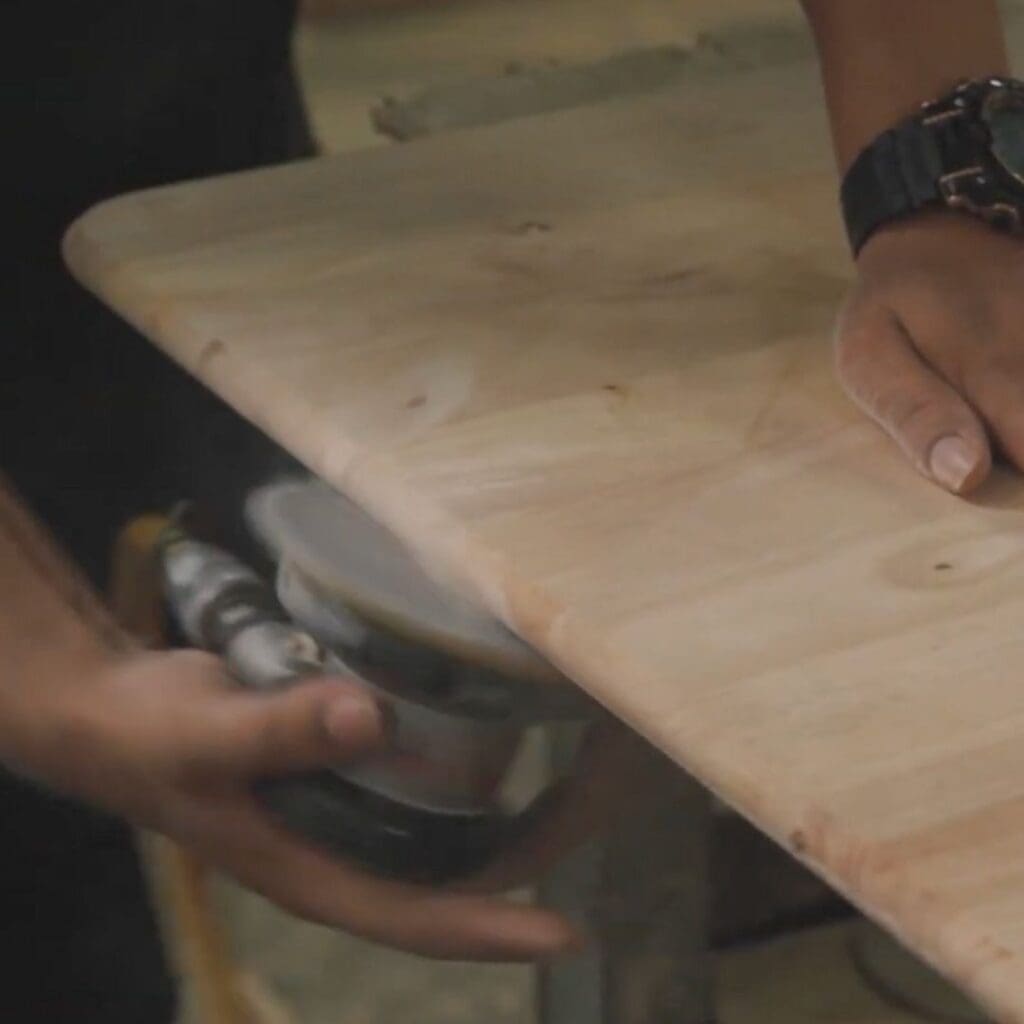
Rubberwood Is Affordable
Compared to other hardwoods like oak or walnut, rubberwood is more affordable, making it accessible for those who want high-quality furniture but cannot afford the high prices of other hardwoods.
Rubberwood Is Biodegradable
Rubberwood can be composted or recycled after it has reached the end of its life cycle, reducing waste.
Rubberwood Is Chemical-Free
The kiln-drying and chemical treatment process used to prepare rubberwood for furniture production does not involve harmful chemicals, making it a safe wood choice.
Rubberwood Supports Local Communities
Rubberwood is primarily grown in Southeast Asia, providing employment opportunities for local communities. We also consider rubberwood a wood with a social conscience as it helps communities and the environment.
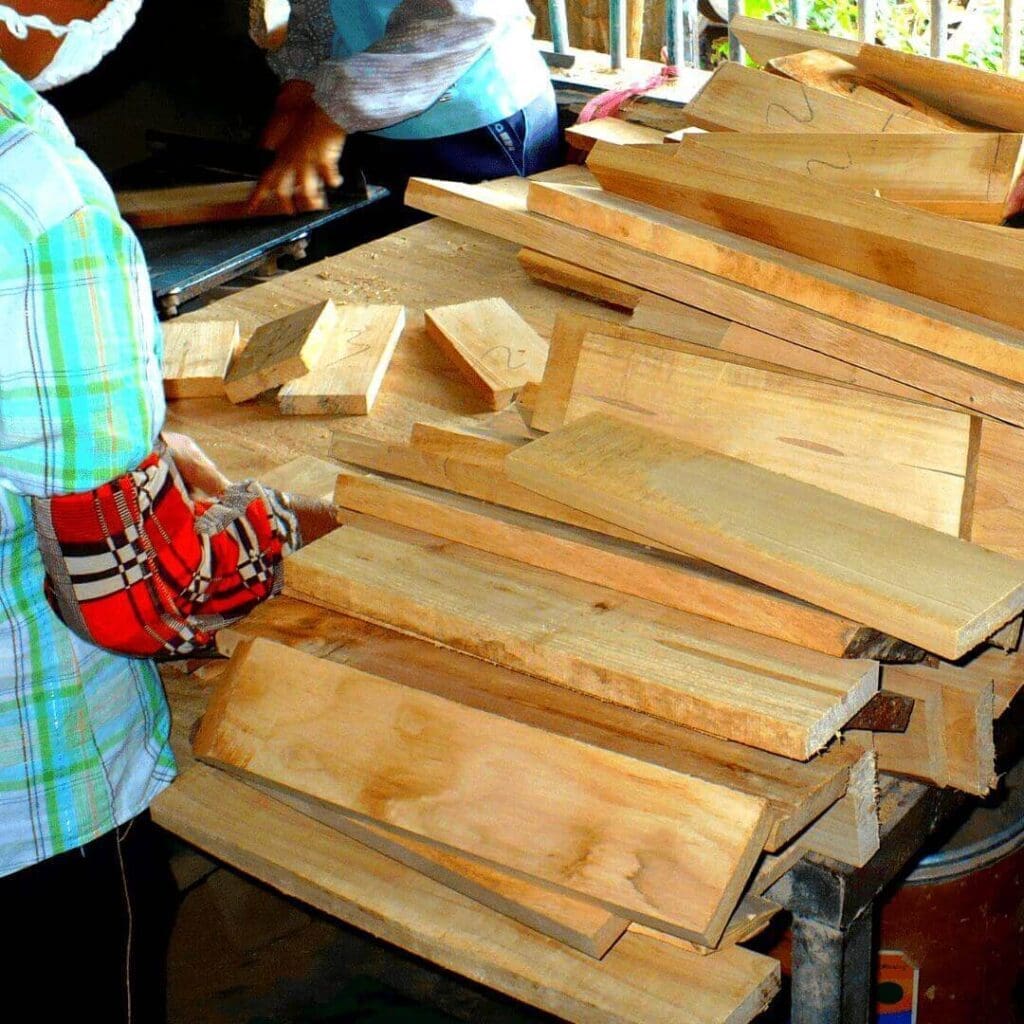
Rubberwood Reduces Deforestation
Using rubberwood reduces the demand for new trees to be cut down, helping preserve forests and reduce the effects of deforestation. The rubberwood trees would be cut down anyway, but by using rubberwood, you are using a tree that needed to be cut down.
Rubberwood Promotes Sustainable Practices
Choosing eco-friendly options like rubberwood promotes sustainable practices and encourages others to follow suit, positively impacting the environment.
Rubberwood Is A Renewable Resource
The Hevea Brasiliensis tree can be tapped for latex for around 25 years before it reaches the end of its productive life cycle. At this point, the tree can be cut down and used for furniture production.
By using rubberwood, we are not only preventing waste but also reducing the demand for new trees to be cut down.
10 Interesting Facts About Rubberwood
Rubberwood, often called plantation hardwood, Parawood, or “Hevea” (from its Latin name Hevea brasiliensis), is an ecologically friendly timber that’s been gaining traction in various industries.
Here are ten interesting facts about Rubberwood:
- Origin: Rubberwood comes from the rubber tree, primarily grown in Southeast Asian countries like Malaysia, Thailand, and Indonesia.
- Latex Production: Before being used for timber, rubber trees are primarily grown for latex extraction. This latex is tapped from the tree and is a primary source of natural rubber.
- Eco-Friendly: Once the rubber tree stops producing latex (typically after about 25-30 years), the trees are harvested for timber instead of being discarded and burned. This reduces waste and makes rubberwood an environmentally sustainable choice.
- Durability: Rubberwood is known for its strength and durability. It’s less likely to warp or shrink compared to many other types of wood.
- Grain Structure: The wood has a tight grain structure, making it ideal for fine and detailed woodworking.
- Non-Toxic: Rubberwood is often favored for making toys and kitchen utensils because it’s a non-toxic and safe material.
- Resistant to Fungi and Bacteria: The wood’s properties make it resistant to molds, fungi, and bacteria, which is beneficial for furniture and kitchen applications.
- Affordability: Compared to many hardwoods, rubberwood is relatively affordable, making it a popular choice for furniture production.
- Versatility: The light color of rubberwood, combined with its smooth grain, makes it easy to stain, veneer, or paint, offering flexibility in design and finish.
- Janka Hardness: On the Janka Hardness Scale (used to determine the material’s resistance to wear and denting), rubberwood scores 960, which is comparable to American black cherry wood, indicating its robust nature.
Rubberwood’s combination of sustainability, durability, and aesthetic appeal makes it an increasingly popular choice for everything from furniture to flooring. It stands as a testament to how industries can evolve to make the most out of resources, turning potential waste into valuable products.
Rubberwood is an eco-friendly and sustainable option for furniture and home decor. Its durability, affordability, and renewability make it an attractive choice for those looking for high-quality and eco-friendly options for their homes. By choosing rubberwood, we can reduce waste, promote sustainable practices, and help preserve forests.
Partnering With Mondoro: Creating Beautiful And Sustainable Rubberwood Home Decor Together

If you’re looking for a company that shares your commitment to sustainability, Mondoro can help you manufacture eco-friendly home decor and home furnishing products from rubberwood.
At Mondoro, we use environmentally friendly and sustainable materials like rubberwood and other eco-friendly materials to create beautiful, functional home decor and furnishings. We are committed to using sustainable practices and minimizing our environmental impact, and we are proud to offer eco-friendly solutions for your home.
Whether you are looking for a statement piece of furniture or a simple accent for your home, Mondoro can help you create the perfect piece that fits your style and values. Contact us today to learn more about our eco-friendly manufacturing processes and start your journey to a sustainable home.
Find out more about how Mondoro can help you create, develop, and manufacture excellent home decor and furniture products – don’t hesitate to contact me, Anita. Check out my email by clicking here or become a part of our community and join our newsletter by clicking here.
Mondoro gives out a FREE Lookbook to anyone interested. You can receive a copy of our latest Lookbook by clicking here.
Listen to our Podcast called Global Trade Gal. You can find it on all major podcast platforms. Try out listening to one of our podcasts by clicking here.
Subscribe to our Mondoro Company Limited YouTube Channel with great videos and information by clicking here.
Frequently Asked Questions About Rubberwood
What are the properties of rubberwood?
Rubberwood has a dense grain that makes it durable and strong. It is also resistant to warping and cracking.
Is rubberwood a good material for furniture?
Yes, rubberwood is a popular material for furniture because of its durability, strength, and attractive grain patterns.
What is the color of rubberwood?
Rubberwood has a light-colored sapwood and a slightly darker heartwood. The color can range from pale yellow to light brown.
Can rubberwood be stained?
Yes, rubberwood can be stained to achieve different colors and finishes.
Can rubberwood be used for outdoor furniture?
Rubberwood is not recommended for outdoor furniture because it is not naturally resistant to moisture and can rot or warp over time.
How does rubberwood compare to other hardwoods?
Rubberwood is generally considered a lower quality hardwood compared to other hardwoods like oak or maple, but it is also less expensive.
How is rubberwood harvested?
Rubberwood is harvested by cutting down mature rubber trees that are no longer productive for latex production.
Is rubberwood environmentally friendly?
Rubberwood is considered environmentally friendly because it is a byproduct of latex production and using it for furniture production helps reduce waste.
Can rubberwood be recycled?
Yes, rubberwood can be recycled and used in other wood products.
Is rubberwood resistant to scratches?
Rubberwood is not particularly resistant to scratches and can be easily dented or marked.
What is rubberwood?
Rubberwood is a type of hardwood that is harvested from the rubber tree (Hevea brasiliensis) which is primarily grown for latex production.
Is rubberwood a sustainable material?
Yes, rubberwood is considered a sustainable material because it is harvested from mature rubber trees that are no longer productive for latex production, and new trees are planted in their place.
Related Content
Is Teak a Coniferous, Evergreen, or Deciduous Tree? 11 Teak Wood Facts
Teak is a deciduous, not evergreen or coniferous tree. Teak leaves do not fall off in the wintertime but in the dry season; in Asia, where teak trees are naturally grown, the dry season is not always the same as winter. As the teak leaves do fall off, the tree is considered to be a deciduous tree.
You can learn more by reading our blog, Is Teak a Coniferous, Evergreen, or Deciduous Tree? 11 Teak Wood Facts, by clicking here.
Why Is Cherry Wood Furniture So Expensive?
Cherrywood is a wood found to be harvested in America and Europe. There are many reasons why Cherrywood is expensive when used on furniture pieces, but the price will also depend upon what kind of wood is used.
You can learn more by reading our blog, Why Is Cherry Wood Furniture So Expensive? by clicking here.
What Are The Types Of Wood Used In Furniture?
Wood for furniture is divided up into complex and softwood. Though the woods have some similarities, they also have some differences. Different looks and types of furniture may require a certain kind of wood. Some wood species will be higher priced, and others will be cheaper; price, durability, look, color, finish, and structure can decide what wood to choose for your furniture piece.
You can learn more by reading What Are The Types Of Wood Used In Furniture? by clicking here.

